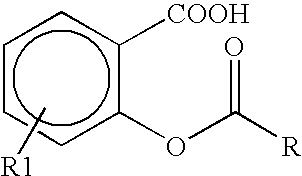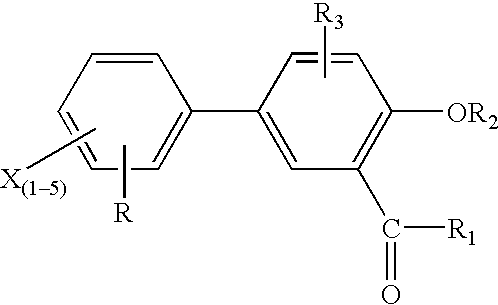Novel diflunisal esters and related compounds
a diflunisal ester and diflunisal ester technology, applied in the field of antiplatelet drugs, can solve the problems of inefficient hepatic extraction of large quantities of aspirin, affecting the effect of vascular endothelium, and thrombotic potential, so as to reduce the risk of thrombosis, and improve the effect of hepatic extraction results
- Summary
- Abstract
- Description
- Claims
- Application Information
AI Technical Summary
Benefits of technology
Problems solved by technology
Method used
Image
Examples
example 2
[0161] Reduced Ulcerogenic Potential and Higher First-Pass Detoxification of O-Acyl Derivatives of Salicylic Acid and Diflunisal compared to Aspirin
[0162] Methods
[0163] Synthesis: O-acyl derivatives of salicylic acid and diflunisal were prepared as above. The respective structures relating thereto were confirmed by infra red, nuclear magnetic resonance and mass spectroscopy. Differential scanning calorimetry was employed to assess the purity of each compound (>98% for all esters).
[0164] Gastrotoxicity: This was assessed in disease-stressed polyarthritic rats (Rainsford et al, 1992, J. Pharm. Pharmacol. 44 476-482) under a procedure approved by the Animal Ethics Committee at the University of Queensland (MED 504 / 94; 610 / 95).
[0165] Female Wistar rats (200.+-.10 g) were given 0.5 mg / mL heat-killed and delipidated Mycobactedium tuberculosis (mixed human strains) suspended in 0.05 mL squalane (Sigma) by subcutaneous injection into the tailbase to elicit polyarthritis (Whitehouse et al, 1...
example 3
[0197] Studies Relating to Hepatic Disposition of O-Acyl Derivatives of Diflunisal
[0198] Materials and Methods
[0199] Analytical
[0200] Apparatus: High-performance liquid chromatography (HPLC) was as described for Example 2.
[0201] HPLC analytical method: The HPLC method employed for the determination of the O-acyl diflunisal derivatives was a modification of the method for assaying aspirin described by Mellick et al. (1996, submitted for publication). The mobile phase used in these HPLC studies consisting of 64:35:1 (acetonitrile: 0.03% (v / v) phosphoric acid:triethylamine) at pH 2.0 (flow rate 1 mL / min) and 0.004% w / v salicylic acid in acetonitrile as internal standard. The effluent was monitored at 237 nm. In this solvent system diflunisal was also assayed, with good separation from the other solute peaks.
[0202] HPLC Assay Validation: Standard solutions of the derivatives were prepared in 2% BSA Krebs-Henseleit buffer (pH 7.4) at concentrations ranging from 1-100 .mu.g / mL. The maximu...
example4
[0247] Hydroxyl Radical Scavenging Potency of O-Acyl Derivatives of Diflunisal and Salicylic Acid in the Ischaemic / Reperfusion Rat Liver
[0248] Oxygen-derived free radicals have been implicated in cell injury observed during ischaemia (Kontos and Hess, 1983, Adv Exp Med Biol 15 269-278) and reperfusion (Ambrosio et al., 1987, Circulation 76 906-915). The mechanism of reactive oxygen species generation through superoxide formation as proposed by McCord (McCord J M, 1985, N Eng J Med 312 159-163) involves the enhanced degradation of adenosine to hypoxanthine during ischaemia as well as the conversion of the cytosolic xanthine dehydrogenase to xanthine oxidase (Roy R S, 1983, Superoxide and Ischaemia: Conversion of Xanthine Dehydrogenase to Xanthine Oxidase, In Oxy Radicals and Their Scavenger Systems. II. Cellular and Medical Aspects, Eds. R. A. Greenwald and G. Cohen, pp.145-153, Elsevier Science / North-Holland, New York) which uses oxygen instead of NAD.sup.+ as an electron acceptor. ...
PUM
| Property | Measurement | Unit |
|---|---|---|
| melting point | aaaaa | aaaaa |
| concentrations | aaaaa | aaaaa |
| concentrations | aaaaa | aaaaa |
Abstract
Description
Claims
Application Information
 Login to View More
Login to View More - R&D
- Intellectual Property
- Life Sciences
- Materials
- Tech Scout
- Unparalleled Data Quality
- Higher Quality Content
- 60% Fewer Hallucinations
Browse by: Latest US Patents, China's latest patents, Technical Efficacy Thesaurus, Application Domain, Technology Topic, Popular Technical Reports.
© 2025 PatSnap. All rights reserved.Legal|Privacy policy|Modern Slavery Act Transparency Statement|Sitemap|About US| Contact US: help@patsnap.com



